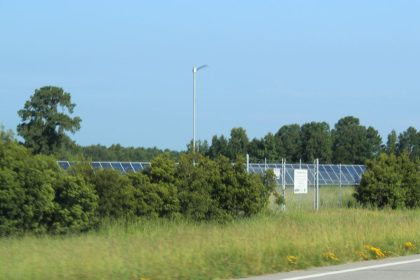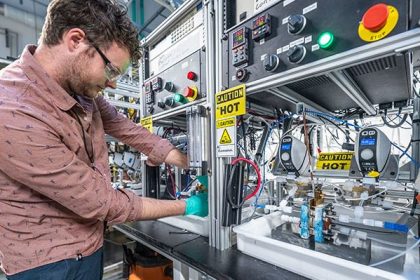Future of Hydrogen the Talk of Major Green Summit

WASHINGTON — Just weeks after the Biden administration rolled out its national strategy for incorporating hydrogen into the nation’s clean energy mix, entrepreneurs, engineers and energy officials converged in a downtown conference center on Monday to discuss how to harness that government support and turn it into a viable, new energy sector.
The two-day event, Hydrogen Americas 2023, is being held at the Ronald Reagan Building and International Trade Center, and as one moved from exhibition hall to speaker presentations and back again, the general mood was one of determined optimism.
Walking the length and breadth of the exhibition hall at the heart of the summit, one was immediately struck by how ‘industrial’ it was with display after display of valves, metallic hoses, various pumps and electrolyzers, machines that literally turn water into the basis for power.
But when it comes to an emerging liquified energy source, these are the tools from which dreams are made.
“Europe is ahead, and has been for a long time, when it comes to gaseous hydrogen, but the vast distances and open spaces in the U.S. makes it impractical here because of the transport costs that would be associated with it,” said Sean Hardy, sales manager for Cryostar, a maker of high-pressure transfer pumps.
“It’s really no different than medical oxygen or industrial gasses or natural gas … in each case, you have to liquefy it to make it viable to transport; what hydrogen represents to many people here is the opportunity to be part of a potentially vast new distribution network,” he said.
“That’s what the hope is, anyway, and you’ll hear a lot about hope over the next couple of days,” Hardy added before observing, “These truly are the early days for hydrogen, but it’s not unlike where we were with liquid natural gas 10 years ago.”
“Back then you could attend an LNG-related conference every week, if you wanted to, and that same kind of excitement is now being focused on hydrogen,” he said.
Cryostar, the company for which Hardy works, is a maker of the high-pressure transfer pumps needed to load and unload liquid hydrogen at power plants, distribution centers and at facilities that will fuel a new generation of hydrogen-powered trucks and transit buses.
No startup — it’s actually been in business for 50 years – Cryostar has seen manias over the next big thing come and go.
Though he’s abundantly hopeful that hydrogen will take off and people will need his products, Hardy also said those embracing hydrogen now would do well to remember the lessons taught by LNG.
Once considered almost on a par with manna from heaven, the market quickly tumbled.
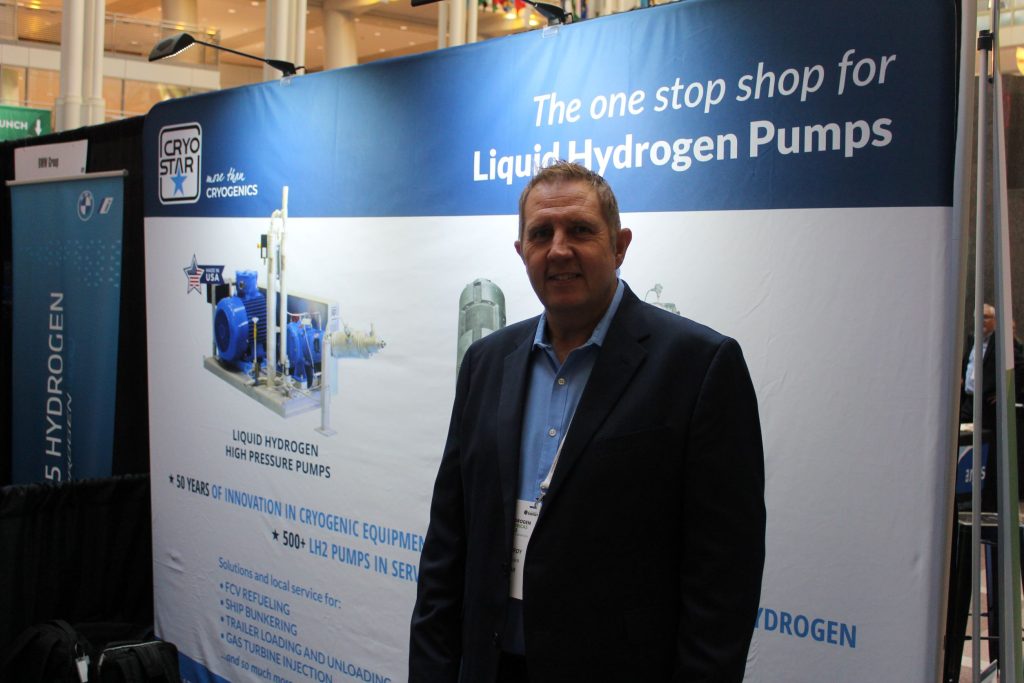
“And there were two reasons for that,” Hardy said. “First, the people that were making the 15 liter engine that ran on [compressed natural gas] stopped making it.
“They still do an 11- or 12- liter engine, which is fine for back-to-basics, but where you’re transporting cargo across a country like the United States, where you have to go up and down hills and so forth, you really need a 1- liter engine to provide the necessary power,” he said.
“The other thing that contributed to killing LNG was the price. When the price of oil was high, LNG was viable, but once the price of oil went down, it became cheaper again to run one’s trucks and so forth on diesel,” he said.
Hardy suspects the same factors could ultimately impact hydrogen.
“But there’s also another factor that could prove challenging for hydrogen — the fact that natural gas is naturally occurring and it’s a relatively simple process to get it out of the ground and to the customer,” he explained.
“Hydrogen on the other hand, despite the fact it is the most abundant element in the world, requires that you undertake a distilling process that requires a lot of energy and that adds to your cost of production,” he continued.
“That could, maybe, stop hydrogen in its tracks … but that’s where you need the government to say, ‘We’ll help support your project and get it going,’” Hardy said
Though Houston, Texas, is still considered the energy capital of the world, hydrogen is mainly gaining the most traction in California, where lawmakers have embraced it as part of an all-of-the-above clean energy strategy.
As a result, a hydrogen fueling infrastructure is slowly but steadily taking shape along the state’s highways and companies like Toyota and Hyundai are actively marketing hydrogen vehicles to trucking firms, municipalities and consumers alike.
“I know I keep mentioning LNG, but it’s essentially the same story,” Hardy said. “California saw LNG as a vehicle for meeting its clean energy goals, and now it’s the state that’s really pushing hydrogen.
“I mean, it’s the only place I can think of where you already have hydrogen filling stations for cars,” he said.
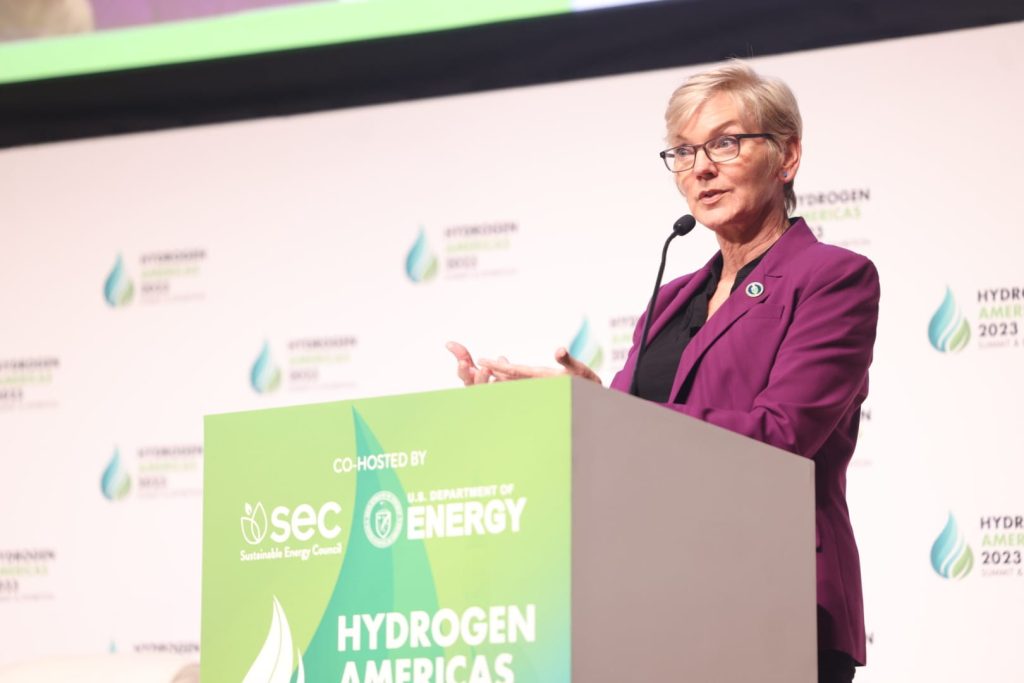
But Hardy and others at the hydrogen summit said the support of individual states will only take the burgeoning hydrogen sector so far. To make lasting progress and permanent gains, the industry needs Washington to be an active partner.
“People have got the equipment. A lot of the technology is the same as has been used in other applications for years. But nobody has the kind of money it will take to build out the infrastructure necessary to get this off the ground,” Hardy said.
“Like any new market, it’s going to take government grants, government money, to get it going,” he said.
Alison Hawkins, commercial development manager for the Hydrogen for Mobility business of Air Products in the Americas, also spoke to the funding issue as she stood next to a large model depicting several hydrogen applications.
“If you try to convince an end consumer to decarbonize while having them absorb the whole cost of that effort themselves, that’s really difficult,” she said.
“Take a trucking fleet, for example. They’re running their fleet on hydrogen and competing against guys down the road who are using diesel. The challenge is, as great and as green as they may be, they can’t really ask their customer to pay more for their services. So they’re at a competitive disadvantage.
“And until there are true mandates, it’s going to be hard to convince people to take on the extra costs associated with hydrogen,” she said.
“That said, the period we’re in now, and which we have to get through, is one in which we need to figure out how to incentivize early adopters without making them absorb all of their costs, yet at the same time, move towards a state of equilibrium where the cost is being borne in the right place,” Hawkins said.
Frank Craddock, director of federal affairs at Orion Strategies, a strategic communications company based in Washington, D.C., said like other clean technologies he and his colleagues have worked with, government investments will flow as more and more hydrogen applications are proven to work.
“Now that’s going to take time,” he said. “But the pressure is there. The country wants to get greener, and there are going to continue to be investments in transportation and pipelines and such going forward.”
Asked how he views state initiatives like those in California, Craddock said “a lot of states” are exploring following its lead, but the thing that’s really gotten their attention is the $8 billion allocated through the Bipartisan Infrastructure Law to create regional hubs to expand the use of hydrogen in industry.
“If the investment in these hubs works, which means if the technology works and they prove to be the job creators they are purported to be, then I think you’ll see a lot more funding, from the federal government, in the future,” Craddock said
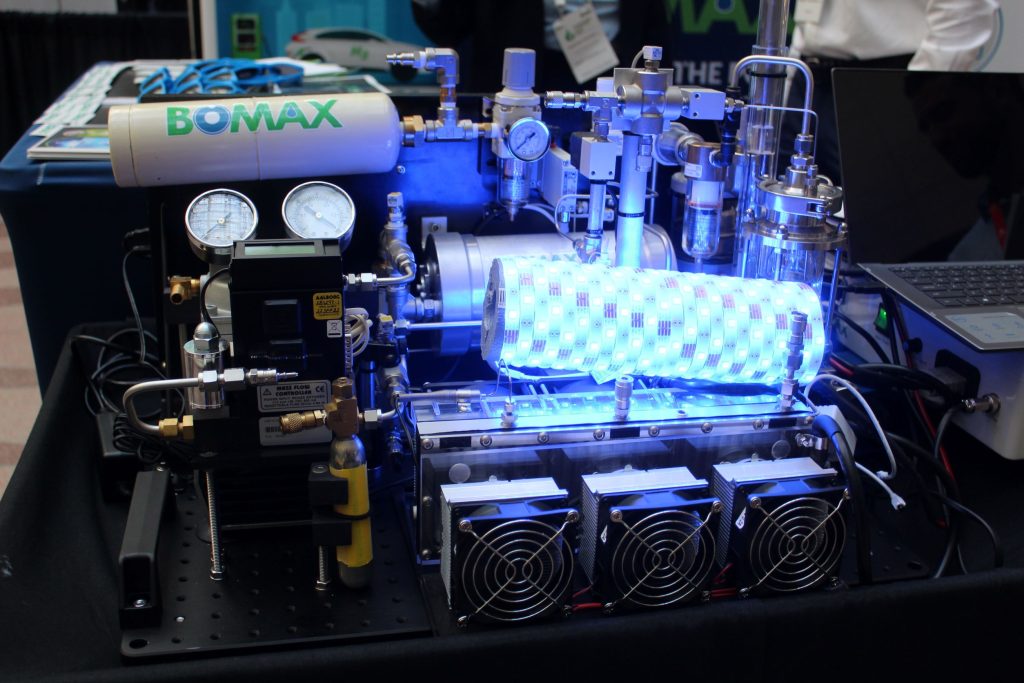
The Biden administration has certainly shown an inclination to play its part.
In early June, the administration released a strategy that calls for the scaling up of U.S. clean hydrogen production to 50 million metric tons by 2050, which would in turn cut 10% of U.S. greenhouse gas emissions between now and then.
That 10% reduction would see decreases from multiple sectors of the economy — particularly hard-to-decarbonize industries like cement and steel where hydrogen is increasingly eyed as a replacement for fossil fuels.
At the summit, many of those with booths in the exhibition hall said they see themselves as playing a leading role in that effort, as well as in the decarbonizing of heavy-duty trucking, cargo and other maritime vessels and aviation.
While almost everyone at the summit gave a big thumbs up to the Inflation Reduction Act and other legislation passed by the last Congress that bestowed tens of billions of dollars on the green and renewable energy sector, the administration hopes its hydrogen strategy will help provide a greater sense of philosophical and market certainty to the fledgling industry.
Among other things, the strategy is seen as a framework for helping to scale the sector while also lowering clean hydrogen costs roughly 80%, to $1/kg, over the next decade.
At the same time, as Craddock mentioned, the Energy Department is providing financial and other support to creation of six to 10 regional hydrogen hubs around the country.
Each hub is expected to create a network of hydrogen producers, consumers, and local connective infrastructure to accelerate the use of hydrogen as a clean energy carrier that can deliver or store tremendous amounts of energy.
“When you’re creating an entirely new sector — which is what the clean hydrogen economy will be — you have to do everything, everywhere, all at once,” Energy Secretary Jennifer Granholm has said.
“That means looking at supply-side strategy, the workforce, the offtake strategy to make sure there are going to be customers. You have to look at the physical locations of supplies, where will hydrogen be taken from, delivered to, and by what means,” she said.
On Tuesday, during a keynote address to the summit, Granholm reiterated that the Biden administration “is betting big—and betting smart—on clean hydrogen.”
“If – and when –our cutting-edge hydrogen programs succeed, the upsides will be huge,” she said.
“Hitting our 2030 clean hydrogen goal would mean producing the same amount of energy used by every bus and train in the United States. It would also mean creating 100,000 new, good-paying jobs,” she continued.
“Hitting our 2040 goal would mean doubling our capacity from 10 million to 20 million metric tons of clean hydrogen. And hitting our 2050 goal would mean producing the equivalent amount of energy used by every bus, train, plane, and ship in the U.S.”
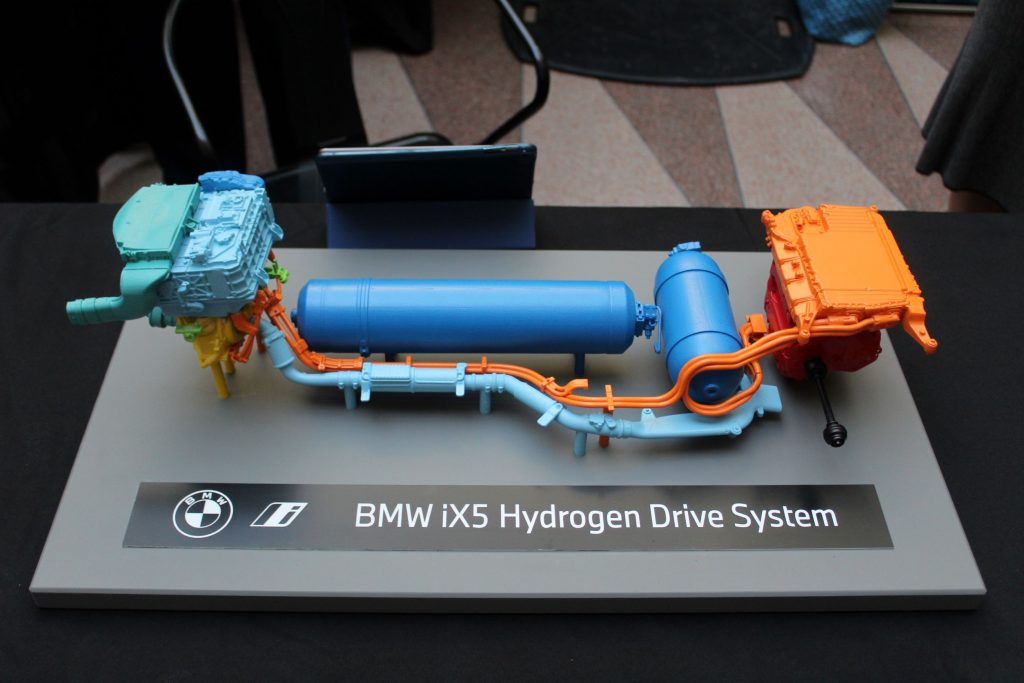
Granholm also spoke of the United States’ desire to work with countries like Chile, which is scaling to five GW of electrolysis capacity by 2025. And Brazil, with its $200 billion investment in clean hydrogen over the next 20 years.
“We want to partner with Uruguay, which is planning to create 35,000 direct skilled jobs in clean hydrogen. And Canada, which intends to supply up to 30% of its energy from hydrogen by 2050,” she said.
“All of us—together—need to develop uniform codes and standards to maximize safety and minimize harmful leakage. We need to ensure that emissions analyses are done consistently across regions, and that certification measures are rigorous, transparent, and practical,” Granholm continued.
Later in her remarks, Granholm sought to underscore the urgency behind the administration’s actions.
“We still have a lot of the hydrogen story left to write, and not a lot of time to write it,” she said. “Last month, the World Meteorological Organization confirmed this was the hottest summer ever
recorded on Earth.
“But, spoiler alert — if we play our cards right, this story’s got a great ending. Cleaner air and water, scores of good-paying jobs, and best of all, nations across the Americas leading the way in this emerging clean energy economy,” the secretary said.
Andre Justus, director of international sales at GSR, a German engineering company, said while there’s no doubt that hydrogen is one of the best solutions when it comes to addressing climate change, he expects its growth to occur incrementally, in part because the demand for hydrogen far exceeds the sector’s ability to produce it.
“Right now people are very excited about hydrogen. It often seems that every industry that can benefit from it wants to have the total amount of hydrogen that’s available at any given time,” he laughed.
“What I see is an industry sector that phases in over a timeframe in which there will be continued demand for coal, natural gas, whatever, and that hydrogen will continue to grow, slowly, until it finally overtakes fossil fuel,” he said.
“That’s what’s coming. Now, the other question, after how long this will take, is how we do it,” he said.

Like Granholm, Justus said because of climate change, there simply isn’t time for any one company or one nation to adopt a go-it-alone approach.
“We have to work together,” he said.
But there’s more to that working together than funding and the development of new technologies. As in the case of most new technologies, the public’s acceptance of hydrogen as part of their everyday lives will depend, in part, on clearing up long-held misconceptions and concerns about the element.
When many people think of hydrogen they think of a gas that has the potential to explode. Some even still point to the 1937 Hindenburg disaster, in which a German airship, filled with gaseous hydrogen, ignited and burned as it approached a mooring mast in Lakehurst, New Jersey.
Though it was lightning and not hydrogen that caused the disaster, the vividness of the images captured by waiting news photographers 86 years ago is hard to erase.
“To those who say, ‘Hydrogen blows up,’ I always say, but so does oxygen, and we breathe it every day,” Hardy said.
Nick Barilo is the executive director for the Center for Hydrogen Safety, an international nonprofit and member organization that is seeking to create a hydrogen community built around best practices and safety knowledge.
Though the group doesn’t advocate for the growth of the hydrogen sector per se, it does have a public-facing role of spreading safety knowledge.
“It’s interesting that you should mention the Hindenburg, because I have worked with a person who wrote a book on the disaster and he did quite extensive research into what actually happened,” Barilo.
“So essentially what happened was the electricity in the air that night ignited the skin of the dirigible, which was made of a combustible material, and the hydrogen then burned — it didn’t explode at all.
“So here’s a historical situation that we all associate with hydrogen, but that’s not what caused the incident,” Barilo said. “So that’s where education comes in and if this sector is going to grow, we’re going to have to educate people about it.
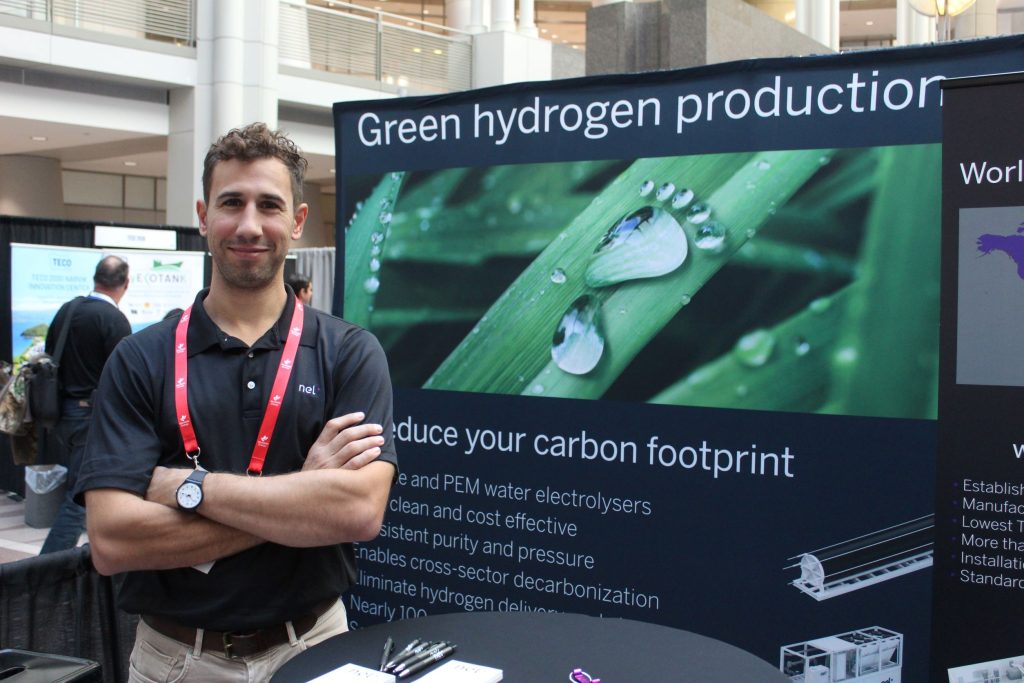
“And that’s going to be a big part of this,” he continued. “As we move forward into the hubs and do these other things, we need to be mindful of the need to inform people and help to answer their questions … helping them to understand that it’s okay. It’s just another fuel. And you can use it safely.”
Barilo smiled.
“One of things that we forget is that a lot of safety lessons had to be learned with all of the energy sources we rely on today,” he said. Even electricity. We all take it for granted. I think we’ve become comfortable, if not complacent about it, but electricity can be dangerous.
“The same is true of gasoline. We don’t think about it because we’re all so familiar with it. But you don’t know when you go to a particular pump whether it has a safety attachment to prevent gas from squirting everywhere when you pull the nozzle from your vehicle. Some don’t, and that’s inherently dangerous.
“Hydrogen on the other hand is an entirely closed system. Hydrogen can’t squirt out all over the place. But it’s a much different system than we’re used to, and that feeds apprehension,” he said.
Looking toward the future, Hardy said he believes it will take some time for hydrogen to make up a truly sizable share of the energy market, but at the same time feels in the near term “there’s a place for everybody in that market.”
“Obviously, many believe that gasoline will continue to dominate because there are just so many cars and so many filling stations. But a number of automakers have said they’re going to stop building gasoline-powered cars in 2030 or so … so that is going to force change,” he said.
“Right now, I guess the best way to describe the hydrogen market is to say we’re kind of riding the wave right now, waiting for some money to come in so somebody can move forward with projects. When that happens, they’re going to need our products,” he said.
Chris Simuro, CEO and president of BoMax Hydrogen, winner of the Department of Energy Hydrogen Shot Incubator Prize, also talked of the way forward.
His company is now in the final stages of developing technology that will enable his customers to make their own hydrogen onsite from, essentially, bacteria in soil and sunlight.
“What I always say when people ask me what it will take to grow this sector is that it will take three things,” Simuro said. “First, we have got to be able to make enough hydrogen to meet the daily requirement, to meet demand. Then we’ve got to do it at a price point that matters and it’s got to be green.
“Right now, those are the three things that are keeping [hydrogen] from happening here in the U.S. … and, of course, we think we’ve got the technology that has the potential to change everything,” Simuro said.
Dan can be reached at [email protected] and @DanMcCue






















